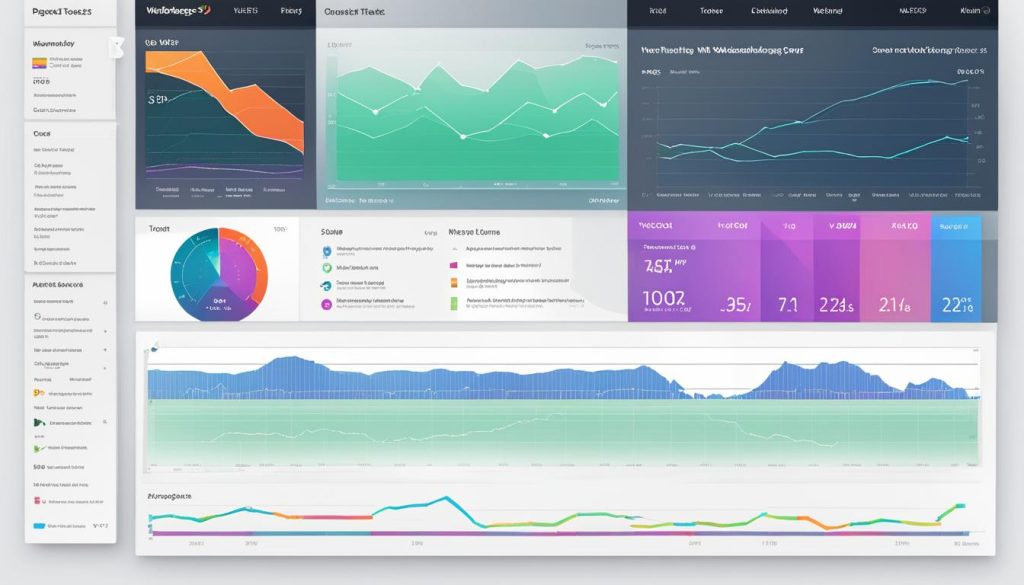As purveyors of digital excellence at Grew Studio, we understand that the user’s online voyage should be swift and seamless. Acknowledging the indispensability of page speed, we dive deep into the intricacies of page speed measurement and enhancement. With the user’s patience thinning faster than ever, and with Google’s nod to page speed’s influence on rankings, our focus lies in deploying comprehensive diagnostic tools and speed optimization tools.
We are steadfast in our commitment to meticulous website performance analysis, to ensure your digital presence isn’t just felt, but swiftly accessed and appreciated. In the emergent landscape where milliseconds can decide the fate of user retention, our CEO Adam Oliver Kollar champions a strategic consultation to boost your website’s loading speed, and in turn, your business’s online success.
Key Takeaways
- Integral role of page speed in user experience and search engine rankings.
- Effective use of diagnostic tools for precise page speed improvement.
- Strategic analysis and optimisation to help reduce website bounce rates.
- Importance of speed optimization tools in achieving superior SEO outcomes.
- How expert consultations can lead to tailored solutions for page speed improvement.
The Critical Importance of Page Speed in SEO and User Experience
As we delve into the intricacies of SEO and user experience, it becomes abundantly clear that page speed is not a mere convenience; it’s a pivotal aspect that influences both realms. Recognising its significance, search engines have included page speed as a weighty ranking factor. Swift loading times, therefore, play a paramount role in providing an enjoyable browsing session. This efficiency contributes to lower bounce rates, with users more likely to engage deeply with the content, not hastily clicking away in frustration. It’s these minute details that culminate in optimised conversion rates.
Data drawn from a sophisticated Google study utilising deep neural network technology, confirms a straightforward link: the swifter the page speed, the lesser the possibility of users abandoning the site. Reflecting on these findings, we grasp the undeniable truth that slow-loading pages not only sour the user experience but also impair the efforts to climb the SEO ranking ladder — inevitably blocking the pathway to substantial organic traffic.
“Pages that load within two seconds boast an average bounce rate of 9%, while those that take five seconds see the rate skyrocket to 38%.”
Therefore, we must underscore the criticality of page speed: not just for maintaining our user’s satisfaction but for ensuring our digital presence remains competitive and visible in this era where speed is synonymous with success.
Here’s a comparative glance at the metrics illustrating the importance of page speed:
| Page Load Time (Seconds) | Bounce Rate Increase | Conversion Rate Impact | Effect on SEO Ranking |
|---|---|---|---|
| 1-3 | 32% | Positive | Favourable |
| 3-5 | 90% | Negative | Unfavourable |
| 5+ | 106% | Highly Negative | Poor |
Optimisation, therefore, is not just a byword in the jargon-filled world of SEO; it is an indispensable part of our strategy to ensure that every digital pathway leads to an experience that captivates and retains users. Leveraging this can result in a ripple effect — better user experience, enhanced SEO rankings, and ultimately, a robust boost in organic traffic and conversion rates.
Understanding Page Speed and Its Impact on Business Performance
In the digital marketplace, the efficiency with which a website operates can have profound implications for its overall business performance. We delve into the critical elements that constitute page speed, unravel its financial impact, and explore how mobile optimization is key to shaping user behaviour.
What Constitutes Page Speed?
At its core, page speed measures the pace at which content fully loads and becomes usable upon a user visiting a webpage. Optimising for faster site speed analysis, we acknowledge that every millisecond counts. Factors ranging from server response times to the rendering of complex files like JavaScript, CSS, and images determine the overall load time.
The Financial Implications of Page Load Times
The correlation between load time and business conversion rates is undeniable. Protracted loading can lead to a notable downturn in engagement and sales, thereby creating a significant financial impact. A meticulous user behaviour analysis can reveal how even the smallest delays might deter potential customers, ultimately affecting the bottom line.
How Mobile Page Speed Influences User Behaviour
With an increasing dependence on mobile devices, mobile optimization has become a cornerstone of digital strategy. Speed is a pivotal factor that not only influences user experience but also contributes to higher retention and conversion rates. Understanding and improving mobile page load times is integral to catering for modern user expectations and behaviours.
Here is a breakdown of how various components of site speed analysis converge to support business conversions:
| Aspect | Influence on Load Time | Impact on Conversions |
|---|---|---|
| Server Response | Initial gateway to content delivery | Direct correlation with bounce rate |
| Rendering Files | Complexity increases processing requirement | Slower rendering affects engagement |
| Image Optimization | Compression can reduce latency | Quicker interaction enhances user experience |
| Mobile Usability | Accelerated load on devices | Improved accessibility boosts conversions |

We must regard site speed not only as a technical metric but also as an essential factor with tangible repercussions on financial returns and market positioning.
Tools for Measuring and Improving Page Speed
At the forefront of digital best practices, we recognise the unparalleled importance of optimising page speed to ensure the most positive user experiences. By focusing on critical performance metrics, our effort to improve a site’s agility not only enhances usability but also significantly boosts its search engine rankings.
Availing ourselves of pioneering speed testing software, such as Google PageSpeed Insights, allows us to administer a comprehensive diagnostic assessment. This tool appraises our website’s performance and pinpoints key areas for load time reduction, directly reflecting on our commitment to speed optimisation.
Google Lighthouse complements our toolkit, extending its capabilities for auditing beyond mere speed. It delves into aspects like accessibility and SEO, each measurable by their respective sets of comprehensive performance metrics.
We utilise Core Web Vitals within Google Search Console for a more encompassing view of a webpage’s fitness, enabling us to stay abreast of real-time user interactions.
The subscription-based Pingdom tool and the open-source WebPageTest each serve as indispensable components of our website analytics array. These resources offer us a myriad of insights across multiple browsers and devices, an essential for cross-platform consistency in performance.
- Insights from Pingdom empower us with precise data focusing on enhancing the reliability and speed of your site.
- WebPageTest, in its free, accessible format, allows us to test and reassess our website’s responsiveness, confirming its robustness in a variety of conditions.
Tapping into these advanced tools, we strive to embody the zenith of digital efficiency by continually refining our websites. This vigilance in deploying the finest speed testing software ensures that our clientele receives nothing short of exceptional outcomes bolstered by the triumvirate of speed, performance, and user satisfaction.
Key Performance Metrics to Monitor for Page Speed Analysis
As we delve into the realm of speed optimization tools and performance analysis, our focus zeroes in on the metrics that provide actionable insights into the efficiency of website navigation and its ultimate impact on the user experience. Speed monitoring is not just about numbers; it’s about understanding the user journey and enhancing it in every possible manner.
Core Web Vitals as a Performance Benchmark
In our pursuit of excellence in website performance, we regard Google’s Core Web Vitals as essential barometers that reflect the health of a website. They are the pulse points that measure loading speeds, interactivity, and visual stability – factors that directly influence not only how users interact with a page but also how search engines perceive and rank the site.

Interpreting Metrics from Diagnostic Tools
Equipped with a suite of diagnostic tools, we meticulously interpret the data to provide us with performance benchmarks that steer our optimization efforts. The insights garnered from these tools facilitate preemptive actions to rectify issues that could potentially derail a seamless user experience. We examine parameters such as First Contentful Paint (FCP), Time to Interactive (TTI), and Cumulative Layout Shift (CLS) to ensure that the visitor’s journey through the website is as fluid and uninterrupted as possible.
- First Contentful Paint (FCP): The time at which the first text or image is painted.
- Time to Interactive (TTI): The point where the main page components are ready to respond swiftly to user input.
- Cumulative Layout Shift (CLS): A measure of the stability of content as it loads on the screen to avoid unexpected layout shifts.
Ensuring these core metrics meet the recommended thresholds is integral to our strategy for delivering a superior user experience. Our ongoing commitment to speed optimisation reflects our dedication towards facilitating website navigation that is not just efficient but also enjoyable.
An Examination of Google’s PageSpeed Insights for Speed Optimisation
In our continuous quest for superior website performance, we often turn to Google PageSpeed Insights. Renowned for its comprehensive speed analysis and robust performance optimization suggestions, it equips us with actionable insights to enhance our client’s digital presence. Let’s delve deeper into understanding the pivotal role of this formidable tool.
The essence of the tool lies in its capability to dissect webpages, scrutinize resource utilisation, and measure the load time for each aspect of a page. Google PageSpeed Insights identifies bottlenecks and provides customised recommendations, steering us towards resource optimization and improved page performance.
| Performance Metric | Description | Impact on SEO |
|---|---|---|
| Fully Loaded Time | The point at which all page resources have completed loading. | Direct correlation with user satisfaction and SEO ranking. |
| First Contentful Paint (FCP) | Measures the time from navigation to when content is first rendered. | A critical metric for first impressions and user engagement. |
| Speed Index | Gauges how quickly contents are visually displayed during load. | Influences user’s perceived loading experience. |
| Largest Contentful Paint (LCP) | Records the time taken for the largest content element to load. | Essential for understanding user’s visual loading experience. |
By harnessing the power of Google PageSpeed Insights to conduct a thorough performance optimization, we assure that every aspect of our client’s website is analysed and fine-tuned. This granular approach to optimization facilitates seamless browsing experiences, ultimately reflecting in enhanced SEO rankings and user satisfaction.
Employing Google Lighthouse for Comprehensive Site Audits
As adept digital custodians, we embrace Google Lighthouse for its capability to perform comprehensive site audits. This open-source gem available within Chrome DevTools is instrumental in assessing a plethora of online parameters – from performance metrics to usability testing and SEO enhancement. Our commitment revolves around leveraging its insights to elevate the end-user experience and further solidify website presence in search rankings.

Initiating an audit with Google Lighthouse is quite effortless, yet it yields a wealth of knowledge. The report that ensues post-analysis is a meticulously detailed guide to improving speed, performance, and accessibility. This tool is especially paramount when releasing new pages or updates to ensure they meet the highest standards of usability and SEO practices.
| Google Lighthouse Audit Feature | Benefits to Your Site | Impact on SEO |
|---|---|---|
| Performance Scoring | Identifies scripts and images that can be optimised to cut down load times. | Directly influences page rank as faster sites are favoured by search engines. |
| Accessibility Evaluation | Aims to pinpoint barriers for disabled users, ensuring an inclusive experience. | Increases content reach and engagement essential for strong search engine visibility. |
| Best Practices | Suggests modern web practices such as HTTPS and correct image aspect ratios. | Encourages trust and reliability factors that are considered by algorithms. |
| SEO Analysis | Reviews on-page SEO elements like title tags, meta descriptions, and more. | Optimises discoverability and categorisation of the site within search engines. |
| Progressive Web App (PWA) Checklist | Verifies the site’s adherence to PWA standards for a native app-like experience. | Boosts user engagement and session length, which are positive SEO signals. |
To conclude, Google Lighthouse serves as an indispensable part of our toolbox for dissecting performance and usability intricacies. We align its detailed recommendations with our strategic improvements, ensuring each action taken is not only heralded by best practices but also by quantifiable advancements in user experience and SEO standing. Through consistent audits, we strive to maintain our position at the vanguard of digital innovation and search engine relevance.
Leveraging the Power of Pingdom for Page Speed Insights
At our studio, we understand the critical need for websites to load quickly, ensuring users stay engaged and conversions are not lost due to impatience. This is where Pingdom becomes an essential part of our toolkit. As a website speed test tool, it provides comprehensive load time analysis, making it an indispensable asset for our speed optimisation projects.
Detailed feedback on website performance is not just a luxury but a necessity in the digital age. Pingdom offers just that, supplying a speed improvement guide specifically tailored to each website it analyses. We capitalise on this feedback to pinpoint exact issues and rectify them, thus enhancing user experience and bolstering SEO outcomes.
In embracing Pingdom’s robust analysis, we gain valuable insights into the various factors affecting a site’s responsiveness. It’s not just about identifying the problem but understanding the underlying cause. Whether it be bulky images, inefficient scripts, or excessive HTTP requests, we deploy strategies to mitigate these issues, offering our clients a competitive edge.
- Assessing individual resource load times
- Evaluating total page size and its components
- Analysis of performance grades for quick insights
- Geographical performance checks for global reach
We believe in not just conducting a one-time website speed test but establishing an ongoing monitoring system. This proactive approach ensures that our clients’ websites consistently perform at their peak, retaining the high-speed standards that modern users expect.
Ultimately, the goal is to help our clients achieve lightning-fast websites that not only please their users but also climb the ranks of search engine results pages. In achieving this, Pingdom stands as a trusted companion in our campaign for speed optimisation. We remain committed to evolving our strategies alongside technological advancements, ensuring our clients’ websites never fall behind.
Utilising WebPageTest for Multi-Browser Speed Testing
As we dive deeper into the realm of performance optimisation, we find that WebPageTest stands as an invaluable ally. This free performance tool is particularly adept at multi-browser and multi-device speed testing, offering a panoramic view of a website’s speed and functionality. In our experience, the insights gained have been absolutely imperative for effective cross-browser testing.
The beauty of WebPageTest lies in its ability to simulate user interactions from different browsers, device capabilities, and connection speeds. Why do we consider this essential? Because understanding the diverse scenarios in which our audience may engage with our sites enables us to tailor our performance optimisation strategies more effectively.
- The software provides detailed performance scores for a plethora of metrics.
- Data is displayed in easy-to-understand formats, including waterfall views.
- Testing can be customised via scriptable scenarios for dynamic web applications.
We cannot emphasise enough the importance of leveraging WebPageTest for comprehensive analysis when embarking on cross-browser testing. The insights gleaned empower us to make informed decisions, ensuring that our sites perform with exceptional speed and reliability, irrespective of how or where they are accessed.

Through this potent free performance tool, the following technical enhancements can be monitored and acted upon:
- Optimisation of images and asset delivery
- Minification of CSS and JavaScript files
- Improvements in server response times across platforms
Ultimately, we champion the use of WebPageTest as part of our commitment to exceptional user experience and steadfastly recommend its integration into any performance optimisation strategy.
Optimisation Strategies for Improved Page Load Times
In our collective pursuit of excellence in website performance, we recognise the profound impact of speed optimization strategy on user experience enhancement. To this effect, we commit ourselves to employing a blend of innovative solutions and tested methodologies.
Enhancing User Experience through Speed Enhancement
Our chief objective remains the refinement of user experience. By doing so, we not only meet but exceed the expectations of our visitors. To facilitate this, a core aspect of our strategy includes minimising HTTP requests, which reduces load times significantly, along with leveraging browser caching. This ensures that repeat visitors enjoy faster page loads – a crucial factor in user retention.
Site Design Considerations for Quick Loading
When addressing website design, we adopt a minimalist approach, stripping down to the essentials. We pay close attention to image sizes, script optimisation and the lean structuring of CSS. These efforts are consciously directed towards establishing an optimal balance between aesthetic appeal and functionality.
Server Response Time and its Influence on Page Speed
The responsiveness of our servers is an underpinning pillar of our speed optimization strategy. As we assess our server response time, we delve into the technical realm of efficient back-end operations, ensuring that our infrastructure is robust and that load balancing is effectively managed to distribute traffic uniformly.
| Optimisation Factor | Action | Impact on Page Load Time |
|---|---|---|
| Minimise HTTP Requests | Combine files, use CSS sprites | Reduces the number of server requests |
| Enable Browser Caching | Set appropriate cache headers | Allows repeat visitors to load pages faster |
| Optimise Images | Compress and use the correct format | Decreases file size for quicker loading |
| Load Balancing | Distribute traffic across servers | Ensures smooth handling of traffic spikes |
Exploring the Role of a Content Delivery Network in Speed Optimisation
As specialists in the digital realm, we at Grew Studio understand the critical necessity of a Content Delivery Network (CDN) in facilitating swift web experiences. A CDN essentially serves as a group of servers, strategically located across various regions, to provide fast content delivery to users worldwide. This network optimisation technique proves pivotal in reducing latency, a paramount factor when it comes to page rendering acceleration and maintaining an edge in the highly competitive online space.

By distributing website content across different nodes, CDNs mitigate the distance between the server and the end-user. Network optimisation through CDNs promises not just latency reduction, but also a fortified defence against common attacks, such as Distributed Denial of Service (DDoS) attacks, ensuring website resilience and continuous content delivery.
Below, you’ll find a concise representation of how the integration of a CDN can impact key website performance metrics:
| Metric | Without CDN | With CDN |
|---|---|---|
| Latency | Higher due to longer distances | Reduced by proximity to users |
| Page Load Time | Longer, affecting user experience | Faster, improving user satisfaction |
| Content Redundancy | Lower, potential for single points of failure | High, with multiple points of distribution |
| Bandwidth Cost | Higher, due to centralized delivery | Optimized, courtesy of distributed caching |
| Website Resilience | Less robust during traffic surges | Enhanced to withstand high traffic loads |
Our advocacy for CDNs is underpinned by their capacity to ensure content delivery is both seamless and economical. By tapping into a content delivery network, businesses can enjoy network optimisation that not only boosts page rendering acceleration but also streamlines the overall website management process.
Insights from Website Analytics: Gaining Actionable Data
As we venture deeper into a data-driven era, website analytics have become our compass, guiding us towards a deeper comprehension of where our websites excel and where they require enhancements. By harnessing actionable insights provided by these sophisticated tools, we unveil opportunities to significantly ameliorate user experience, specifically in the realm of page loading speeds.
A cogent analysis must transcend mere examination of top-level statistics. By diving into the finer nuances of speed analysis, we can pinpoint and rectify specific impediments that throttle site performance. It’s imperative to consistently monitor and analyse the user pathways tracking data, revealing the intricate web of navigation that users traverse within our sites. This insight affords us an empirical foundation upon which to sculpt an informed website improvements guide.
| Metrics | Findings | Improvement Tactics |
|---|---|---|
| Page Load Time | High variance in load time across pages | Optimise images, leverage browser caching |
| First Contentful Paint (FCP) | Slower on mobile devices | Implement responsive design, minimise critical render-blocking resources |
| Largest Contentful Paint (LCP) | Exceeds 4 seconds on key landing pages | Enhance server response times, remove unnecessary third-party scripts |
| Cumulative Layout Shift (CLS) | Instances of unexpected layout shifts | Stabilise layouts, preload important assets |
We at Grew Studio, under the stewardship of Adam Oliver Kollar, recognise that developing a strategic approach spearheaded by analytical rigour is the cornerstone of facilitating superior user experiences. We’re committed to proactively iterating on these analytics, thus perpetually propelling websites to the zenith of performance and usability standards.
Conclusion
In the ever-evolving landscape of digital technology, the imperative for continuous performance improvement in the realm of website speed is not just beneficial, but necessary. To maintain and enhance user engagement, our focal point must rest firmly on the implementation of structured speed monitoring. This ongoing process assures that the performance of our websites aligns with the latest user requirements and search engine algorithms. As we cast our gaze into the future, it is evident that keeping up with these developments is not simply about maintaining the status quo, but about pushing the boundaries of what’s achievable.
Continuous Improvement and Monitoring for Optimal Performance
At the core of sustaining exceptional website standards is a robust system of regular assessment and revision. We, as webmasters and digital strategists, must harness the insights from state-of-the-art diagnostic tools to spearhead a regimen of continuous improvement. This entails a dynamic approach to website maintenance, where we actively seek and apply incremental enhancements, thereby ensuring that our web operations are performing at their peak. Such vigilance in optimisation secures the foundation for both current and future successes.
Embracing Future Technologies for Page Speed Enhancement
Looking ahead, the adoption of future technologies emerges as a vital step in surmounting the challenges posed by increasing expectations for rapid online experiences. Our commitment to leveraging cutting-edge innovations will provide the catalyst needed to propel page speed performance to the forefront of industry standards. This strategy not only underscores our dedication to optimal website maintenance but also amplifies our resolve to offer an unparalleled user experience reflective of modern-day demands.
FAQ
What are some influential diagnostic tools for measuring and improving page speed?
Some leading diagnostic tools for page speed improvement include Google PageSpeed Insights, Google Lighthouse, Pingdom, and WebPageTest. These tools provide detailed website performance analysis and are instrumental in optimizing speed through actionable feedback.
Why is page speed so critical for SEO and user experience?
Page speed is crucial for SEO because it impacts search engine rankings and user experience by influencing bounce rates, conversion rates, and organic traffic. A fast-loading website enhances user engagement and is more likely to retain visitors, leading to better search performance and higher conversions.
What aspects constitute page speed and how does it affect business performance?
Page speed covers all aspects of how quickly content is visibly populated on a webpage, including the time to first byte and full page load. It directly impacts business performance by affecting user satisfaction, bounce rates, and conversion rates, which translate into the financial success of online enterprises.
How do mobile page speed and user behaviour interact?
Mobile page speed profoundly influences user behaviour. Faster mobile experiences lead to higher engagement and lower abandonment rates. With the increasing predominance of mobile browsing, optimizing for mobile speed is essential for maintaining competitive business conversions and user retention.
What are the key metrics to monitor when analyzing page speed?
When analyzing page speed, key performance metrics include load time, start render time, Time to First Byte (TTFB), and fully loaded time. Google’s Core Web Vitals, which focus on largest contentful paint, first input delay, and cumulative layout shift, are also critical benchmarks for assessing page performance.
Why is Google’s PageSpeed Insights tool important for speed optimisation?
Google’s PageSpeed Insights is a vital tool for speed optimisation as it provides specific and actionable recommendations to improve a website’s performance based on real-world and lab data. It helps developers identify resource optimization opportunities and implement strategies that can significantly reduce load times.
What benefits does Google Lighthouse provide for comprehensive site audits?
Google Lighthouse benefits comprehensive site audits by evaluating the performance, accessibility, best practices, and SEO of webpages. It offers detailed feedback on issues and actionable advice on improvements, supporting developers in creating an optimised and user-friendly site.
How can Pingdom help attain detailed insights into page speed?
Pingdom provides detailed insights into page speed by analyzing individual page elements, assessing their load times, and offering a clear breakdown of potential performance bottlenecks. With its wealth of feedback, website owners can make informed decisions to improve load times and enhance site performance.
Why might you use WebPageTest for cross-browser speed testing?
WebPageTest is an ideal choice for cross-browser speed testing because it allows assessment of a website’s performance across different browsers and devices, providing a realistic view of user experiences. This information is critical for identifying specific compatibility issues and ensuring a uniformly fast experience for all users.
What are some effective speed optimisation strategies for improving page load times?
Effective strategies for improving page load times include optimizing images, leveraging browser caching, reducing redirects, minifying CSS, JavaScript, and HTML, using a Content Delivery Network (CDN), and improving server response times through better hosting solutions or advanced configuration.
How does a Content Delivery Network (CDN) facilitate speed optimisation?
A CDN facilitates speed optimisation by hosting website content on a global network of servers. This enables the delivery of content from the nearest server to the user, reducing latency and improving page rendering speeds. As a result, a CDN can significantly boost site performance, especially for geographically dispersed audiences.
What actionable data can website analytics provide for page speed improvements?
Website analytics can provide a range of actionable data for page speed improvements, such as identifying slow-loading content, poorly performing pages, and visitor browsing patterns. These insights allow webmasters to fine-tune their speed optimisation strategies and enhance overall user experience based on empirical evidence.
How crucial is continuous monitoring and improvement for maintaining optimal website performance?
Continuous monitoring and iterative improvement are vital for maintaining optimal website performance. By regularly assessing performance metrics, diagnosing new issues, and adjusting strategies, webmasters can keep pace with technological advancements, changing user expectations, and evolving web standards to ensure peak website efficiency.





